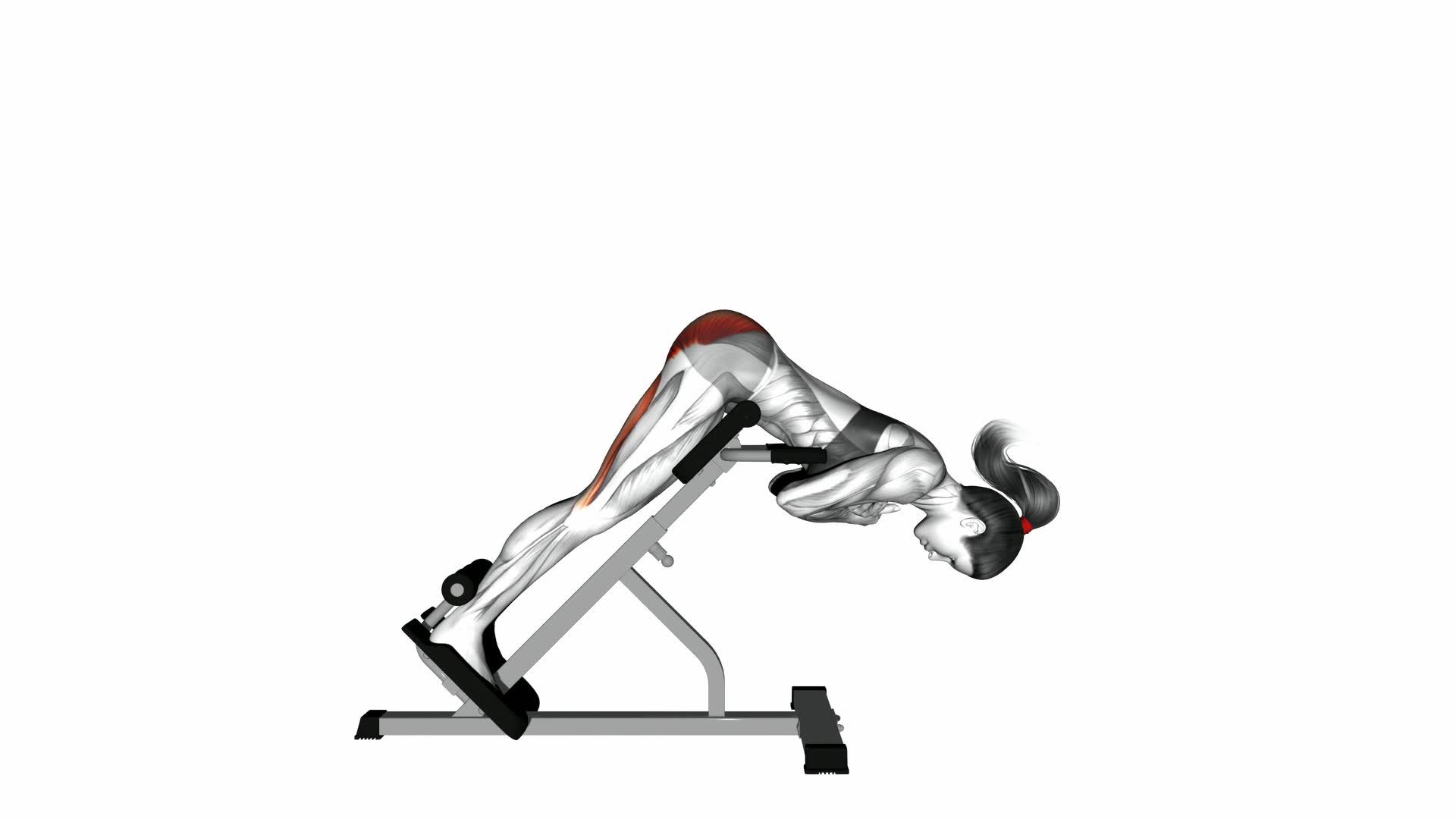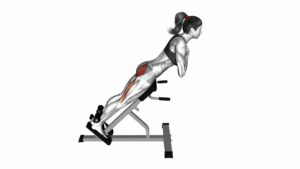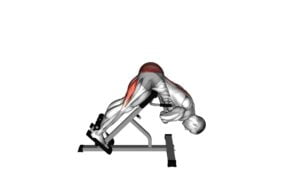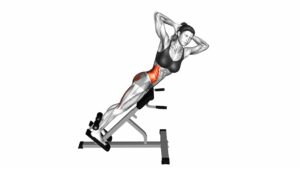45 Degree Hyperextension (Arms in Front of Chest) (Side-Pov) – Video Exercise Guide & Tips

Looking to strengthen your core and improve your posture? Check out this video exercise guide for the 45 degree hyperextension (arms in front of chest) from a side-pov.
Watch This Exercise Video
In just a few minutes, you'll learn the proper setup, execution, and breathing techniques for optimal results.
Plus, we'll cover common mistakes to avoid and provide progressions and variations for advanced users.
Get ready to take your fitness to the next level with this informative and concise guide.
Let's get started!
Key Takeaways
- Proper setup and positioning are essential for performing the 45 Degree Hyperextension correctly and effectively.
- Engaging the core muscles before starting the exercise helps to enhance performance and prevent injury.
- Maintaining proper body alignment and posture throughout the exercise maximizes its effectiveness.
- Using proper breathing techniques, such as inhaling deeply before starting the movement and exhaling during the exertion phase, can improve results and overall performance.
Proper Setup and Positioning
How should you position yourself for the degree hyperextension exercise? Proper technique and positioning are key to getting the most out of this exercise while minimizing the risk of injury.
To begin, stand with your feet shoulder-width apart and your knees slightly bent. Place your hands on your hips or cross them over your chest. Engage your core muscles by pulling your navel towards your spine. This will help stabilize your body throughout the movement.
As you lower your upper body, focus on hinging at the hips and maintaining a neutral spine. Avoid rounding your back or arching excessively. Keep your shoulders relaxed and your chest lifted. Slowly descend until you feel a stretch in your hamstrings, then engage your glutes and hamstrings to return to the starting position.
Common errors to watch out for include using momentum to swing your body up or down, which can strain your lower back. It's also important to avoid locking your knees at the top of the movement, as this can lead to hyperextension and potential injury.
Engaging the Core Muscles
To engage your core muscles during the degree hyperextension exercise, tighten your abdominal muscles and maintain a strong and stable core throughout the movement. This won't only enhance your performance but also help prevent injury.
Here are three key steps to effectively engage your core during the degree hyperextension exercise:
- Start by contracting your abdominal muscles: Before you begin the exercise, consciously tighten your abs as if you were trying to bring your belly button in towards your spine. This action activates the deep core muscles, providing stability and support to your spine.
- Maintain proper posture: Throughout the exercise, focus on keeping your spine in a neutral position. Avoid arching your back excessively or rounding your shoulders. By maintaining good alignment, you promote core stability and minimize the risk of strain or injury.
- Breathe deeply and engage your pelvic floor: As you perform the degree hyperextension exercise, remember to breathe deeply and engage your pelvic floor muscles. This not only helps to further activate your core but also promotes overall core stability and control.
Executing the Exercise With Correct Form
To execute the exercise with correct form, it's important to focus on proper body alignment.
Keep your spine straight and aligned with your hips, avoiding any excessive arching or rounding of the back.
Engage your core muscles throughout the movement to provide stability and support.
Proper Body Alignment
Maintain proper body alignment by keeping your spine straight and engaging your core while executing the degree hyperextension exercise. Here are some body alignment tips to help you maintain proper form throughout the exercise:
- Stand with your feet hip-width apart and your knees slightly bent to ensure stability.
- Keep your shoulders relaxed and down, away from your ears.
- Align your head with your spine, avoiding any excessive forward or backward tilt.
By following these tips, you can prevent unnecessary strain on your back and maximize the effectiveness of the degree hyperextension exercise.
Engaging Core Muscles
Engage your core muscles throughout the exercise to ensure proper form and maximize the effectiveness of the degree hyperextension. Core stability is crucial for maintaining balance and control during this movement.
By engaging your core, specifically by activating your abdominal muscles, you create a strong foundation for the exercise and prevent excessive strain on your lower back. To engage your core, imagine pulling your belly button towards your spine and maintaining this contraction throughout the entire movement. This will help to stabilize your torso and allow for better control and alignment.
By prioritizing core engagement, you won't only improve your form but also enhance the overall effectiveness of the degree hyperextension.
Now, let's move on to the next section and discuss how to avoid excessive arching.
Avoiding Excessive Arching
As you perform the degree hyperextension, focus on keeping your back straight and avoiding excessive arching. Maintaining a neutral spine is crucial to prevent overextension and protect your lower back from strain or injury.
Here are three important tips to help you execute the exercise with correct form:
- Engage your core muscles: By activating your abdominal muscles, you provide stability and support to your spine, reducing the likelihood of excessive arching.
- Control the movement: Avoid using momentum to swing your body during the exercise. Instead, focus on controlled and deliberate movements, ensuring that your back stays straight throughout.
- Use appropriate weight: Start with a manageable weight that allows you to maintain proper form. Gradually increase the weight as your strength and technique improve, always prioritizing maintaining a neutral spine.
Breathing Techniques for Optimal Results
To maximize your results during the degree hyperextension exercise, it's important to focus on proper breath control.
Remember to exhale as you exert force and inhale during the relaxation phase of the movement.
This breathing technique helps to stabilize your core and maintain proper form, allowing you to get the most out of each repetition.
Proper Breath Control
Breathe properly during the Degree Hyperextension exercise to maximize your results. Proper breath control is essential for achieving optimal benefits from this exercise. Here are three key breathing techniques to keep in mind:
- Inhale deeply before starting the movement: Take a deep breath in through your nose, filling your lungs with air. This will help oxygenate your muscles and prepare your body for the exercise.
- Exhale during the exertion phase: As you extend your arms in front of your chest, exhale forcefully through your mouth. This will help engage your core muscles and increase the effectiveness of the movement.
- Maintain a steady rhythm: Try to establish a consistent breathing pattern throughout the exercise. This will help you maintain control and stability, allowing you to perform the Degree Hyperextension with precision and efficiency.
Exhale During Exertion
To optimize your results during the Degree Hyperextension exercise, exhale forcefully through your mouth as you extend your arms in front of your chest. Proper breathing techniques play a crucial role in achieving optimal results during any workout. When you exhale during exertion, you engage your core muscles more effectively, allowing for greater stability and control. This can lead to improved performance and reduced risk of injury.
Additionally, exhaling forcefully can help to release tension and stress, promoting relaxation and focus. By incorporating proper breathing techniques into your exercise routine, you can enhance your overall workout experience and maximize the benefits of each movement.
Inhale During Relaxation
When you inhale during relaxation, you allow your body to replenish oxygen levels and prepare for the next phase of the Degree Hyperextension exercise. Proper breathing techniques are essential for optimal results and can enhance your overall performance. Here are three key reasons why you should focus on inhaling during relaxation:
- Replenishing Oxygen: Taking deep breaths during relaxation helps to replenish oxygen levels in your body. This ensures that your muscles receive the necessary oxygen to function efficiently during the exercise.
- Promoting Relaxation: Inhaling deeply and consciously during relaxation techniques can help calm your mind and promote a sense of relaxation. This can help you stay focused and centered throughout the exercise.
- Preparing for the Next Phase: Inhaling during relaxation allows you to prepare your body for the next phase of the Degree Hyperextension exercise. It helps you gather energy and mentally prepare for the exertion that follows.
Common Mistakes to Avoid
To avoid common mistakes while performing the degree hyperextension exercise with arms in front of your chest, follow these tips.
First and foremost, make sure to maintain proper technique throughout the exercise. One common mistake is arching your back excessively, which can put strain on your lower back and lead to injury. Instead, focus on engaging your core muscles to keep your spine in a neutral position.
Another mistake to avoid is using momentum to swing your body up and down during the exercise. This not only diminishes the effectiveness of the exercise but also increases the risk of injury. Instead, perform the movement in a controlled manner, using your glutes and hamstrings to lift your body up and lower it down.
Additionally, it's important to avoid locking your knees at the top of the movement. This can place unnecessary stress on your joints. Instead, keep a slight bend in your knees throughout the exercise to protect your joints and ensure proper alignment.
Progressions and Variations for Advanced Users
As an advanced user, you can take your degree hyperextension exercise with arms in front of your chest to the next level by incorporating progressions and variations. Here are three ways to challenge yourself and continue making progress:
- Increased Range of Motion: Start by performing the degree hyperextension exercise on a stability ball instead of a flat surface. This will require more core stability and balance, making the exercise more challenging.
- Weighted Degree Hyperextension: Once you have mastered the bodyweight version, you can add resistance by holding a dumbbell or kettlebell against your chest. This will increase the difficulty and further strengthen your back muscles.
- Single-Leg Degree Hyperextension: To enhance the stability and strength of your hips, try performing the exercise on one leg. This won't only target your back muscles but also engage your glutes and improve overall balance.
Remember to always maintain proper form and start with lighter weights or progressions before moving on to more challenging variations. By incorporating these progressions and variations into your degree hyperextension exercise, you can continue to push yourself and achieve even greater results.
Frequently Asked Questions
How Many Sets and Repetitions Should I Perform for the Degree Hyperextension Exercise?
For the degree hyperextension exercise, it's important to find the right balance between sets and repetitions. Start with 2-3 sets of 10-12 repetitions and gradually increase as you build strength and endurance.
However, listen to your body and avoid pushing through discomfort in your lower back. It's always better to prioritize form and proper technique over the number of sets and repetitions.
Consult with a fitness professional for personalized guidance.
Is It Normal to Feel Discomfort in the Lower Back While Performing This Exercise?
It isn't uncommon to experience discomfort in your lower back while performing the degree hyperextension exercise. This could be due to improper form and technique.
To prevent this, make sure you maintain a neutral spine position throughout the exercise and engage your core muscles to support your lower back.
It's important to listen to your body and adjust the exercise as needed to avoid any pain or injury.
Can the Degree Hyperextension Exercise Help Improve Posture?
Incorporating the degree hyperextension exercise into your daily routine can have numerous benefits for improving your posture. By targeting the muscles in your back, this exercise helps to strengthen and stabilize your spine, leading to better alignment and posture.
To maximize results, it's important to execute the degree hyperextension exercise properly. Focus on maintaining a neutral spine position, engaging your core, and using controlled movements.
Remember to consult a professional if you have any concerns or discomfort while performing this exercise.
Is It Necessary to Use Weights or Resistance Bands for This Exercise?
Incorporating degree hyperextensions into your workout routine without weights or resistance bands can still provide several benefits. This exercise helps strengthen your back muscles, improve posture, and increase flexibility.
To perform it correctly without weights or bands, stand with your feet shoulder-width apart and arms crossed in front of your chest. Keep your core engaged and slowly lean back, maintaining a straight spine. Return to the starting position and repeat.
Remember to focus on proper form and technique to maximize the benefits.
Are There Any Modifications for Individuals With Pre-Existing Shoulder or Back Injuries?
If you have pre-existing shoulder or back injuries, it's important to modify your degree hyperextension workouts. Consider alternative exercises that put less strain on these areas, such as gentle stretches or low-impact exercises.
It's also crucial to warm up properly before any workout to prevent further injury. Incorporating stretching exercises specific to your shoulder and back can help prepare your muscles and joints for the movements involved in degree hyperextension.
Always listen to your body and consult with a healthcare professional for personalized advice.
Conclusion
In conclusion, the 45 degree hyperextension exercise with arms in front of the chest is a great way to strengthen and engage the core muscles.
By using proper form, breathing techniques, and avoiding common mistakes, you can optimize your results.
For advanced users, there are progressions and variations available to challenge yourself further.
Incorporate this exercise into your routine for improved core strength and stability.

Author
Years ago, the spark of my life’s passion ignited in my mind the moment I stepped into the local gym for the first time. The inaugural bead of perspiration, the initial endeavor, the very first surge of endorphins, and a sense of pride that washed over me post-workout marked the beginning of my deep-seated interest in strength sports, fitness, and sports nutrition. This very curiosity blossomed rapidly into a profound fascination, propelling me to earn a Master’s degree in Physical Education from the Academy of Physical Education in Krakow, followed by a Sports Manager diploma from the Jagiellonian University. My journey of growth led me to gain more specialized qualifications, such as being a certified personal trainer with a focus on sports dietetics, a lifeguard, and an instructor for wellness and corrective gymnastics. Theoretical knowledge paired seamlessly with practical experience, reinforcing my belief that the transformation of individuals under my guidance was also a reflection of my personal growth. This belief holds true even today. Each day, I strive to push the boundaries and explore new realms. These realms gently elevate me to greater heights. The unique combination of passion for my field and the continuous quest for growth fuels my drive to break new ground.







